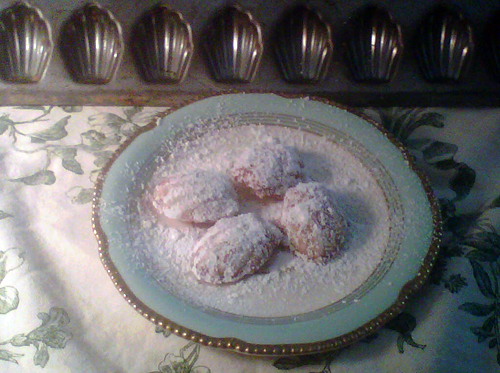What ever happened to dessert as spectacle? Too often, dessert is something that happens out of sight. It's made earlier in the day and tucked away; or it's bought from a bakery or dug out of the freezer, the frozen last resort of mango sorbet or some bite-sized thing from Trader Joe's. The flaming drama of crepes Suzette and bananas Foster, it seems, is long behind us.
But why not reclaim the last course's potential as a little bit of interactive performance? After all, your guests have already been fed. If you screw up, no one's going to have to call for pizza delivery on the way home, loudly bemoaning your hubris in the kitchen. No one thinks you can just make a cake, snap, like that, right under their noses while the dishes are being cleared and the coffee made. Thus, I've turned what is actually a fault--not getting it together on time to show up on the doorstep with a cake already baked--into a party trick, showing up with a bagful of ingredients secretly pre-measured and ready to mix and bake. Certain simple butter cakes, especially those topped with sliced fruit and an aromatic sprinkle of cinnamon sugar, like this ever-popular plum torte, are perfect for this, with the added benefit of making everyone's mouth water with their alluring scent of browning butter, sugar, spice, and fruit.
Madeleines, those dainty, shell-shaped little cakes, are even easier, and have the added benefit of being French and therefore, to American eyes, fancy. They also give those who have put their time in reading Proust a chance to show off, especially if they can quote the relevant passages in the original. You can please, or one-up, these people by serving a tisane de tilleul (linden-flower tea), since that is what Proust's narrator was drinking when his fragment of madeleine, soaked in the tea, brought forth its famously prolific gush of memory.)
Now, the thing about madeleines is, they're at their most delectable fresh out of the oven. Yes, the ones sold three at a time in little plastic bags at Starbucks or out of the vending machines in the Paris Metro are still pretty good; as spongy little cakes go, they're surprisingly resilient. But I still remember the grande geste of some very posh French restaurant in New York City where, post-dessert but pre-check, the waiter brought out a complementary bowl, swaddled in a huge napkin, that was unfolded to reveal freshly baked madeleines snuggled in the white linen like baby birds in a nest. Ooh la la, how I wanted to kiss that waiter and leave him a huge, huge tip!
